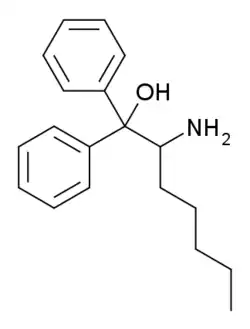Hexapradol
 | |
| Clinical data | |
|---|---|
| Other names | α-Butyl-β-hydroxy-β-phenylamphetamine; α-Pentyl-β-hydroxy-β-phenyl-2-phenethylamine; β-Phenyl-2-phenylheptanolamine |
| ATC code |
|
| Identifiers | |
| |
| CAS Number | |
| PubChem CID | |
| ChemSpider | |
| UNII | |
| ChEMBL | |
| CompTox Dashboard (EPA) | |
| Chemical and physical data | |
| Formula | C19H25NO |
| Molar mass | 283.415 g·mol−1 |
| 3D model (JSmol) | |
| |
| |
Hexapradol (INN) is a psychostimulant drug which was never marketed.[1]
It also had cytoprotective/antiulcer properties.[2]
Synthesis
Synthesis methods are described.[3]
See also
References
- ^ Ganellin CR, Triggle DJ (21 November 1996). Dictionary of Pharmacological Agents. Vol. 2. CRC Press. p. 1023. ISBN 978-0-412-46630-4. Retrieved 26 April 2012.
- ^ Scuri R, Mondani G, Fantini PL, Dàlla Valle V, Valsecchi B (September 1984). "Hexaprazol: a new antiulcer drug with a cytoprotective action". Bollettino Chimico Farmaceutico. 123 (9): 425–38. PMID 6529496.
- ^ GB 805511, "1,1-diaryl-2-aminoalkanols", published 1958-12-10, assigned to Mead Johnson & Co.
This article is issued from Wikipedia. The text is available under Creative Commons Attribution-Share Alike 4.0 unless otherwise noted. Additional terms may apply for the media files.